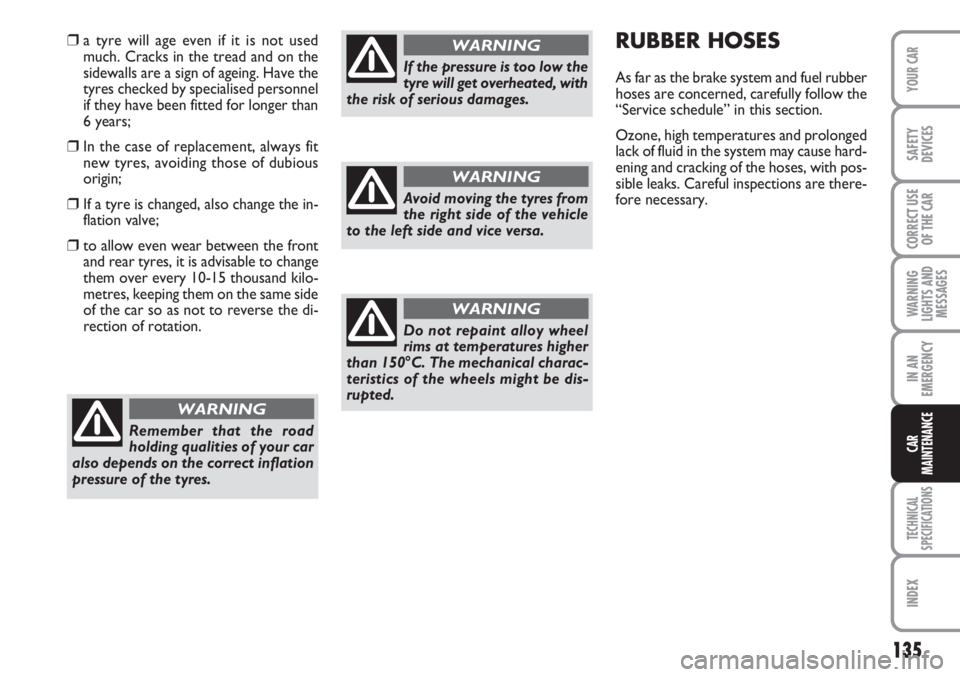Page 126 of 170

125
WARNING
LIGHTS AND
MESSAGES
TECHNICAL
SPECIFICATIONS
INDEX
YOUR CAR
SAFETY
DEVICES
CORRECT USE
OF THE CAR
IN AN
EMERGENCY
CAR
MAINTENANCE
SERVICE SCHEDULE
Service coupons shall be performed every 30,000 km
Thousands of kilometres
Check tyre conditions/wear and adjust pressure
if required
Check light system operation (headlights, direction indicators,
hazard lights, passenger compartment lights, boot lights,
instrument panel warning lights, etc.)
Check the operation of the windscreen wiper/washer system,
adjust the sprayers
Check the position and wear of the windscreen and
rear window wiper blades
Check front disc brake pad condition and wear and
operation of pad wear signalling
visually inspect the conditions of: bodywork, underbody
protection, pipes and hoses
(exhaust - fuel - brakes), rubber parts
(boots, sleeves, bushes, etc.)
Check cleanness of locks, bonnet and boot and lever
cleanness and lubrication
Check tension and if necessary adjust the accessory
drive belts
Visually inspect the accessory drive belt conditions
Replace accessory drive belts
Check and adjust handbrake lever stroke30 60 90 120 150 180
●●●●● ●
●●●●● ●
●●●●● ●
●●●●● ●
●●●●● ●
●●●●● ●
●●●●● ●
●●
●●
●
●●●●● ●
Page 128 of 170

127
WARNING
LIGHTS AND
MESSAGES
TECHNICAL
SPECIFICATIONS
INDEX
YOUR CAR
SAFETY
DEVICES
CORRECT USE
OF THE CAR
IN AN
EMERGENCY
CAR
MAINTENANCE
DEMANDING
USE OF THE CAR
Should prevailing use of the car be under
one of the following specially heavy con-
ditions:
❒dusty roads;
❒short distances (less than 7-8 km) re-
peated and with external tempera-
tures below zero;
❒frequently idling engines or long dis-
tance low speed driving or in case of
a long term inactivity;
❒in cities;
perform the following inspections more
frequently than shown on the Service
Schedule:
❒check front/rear disc brake pad con-
dition and wear;
❒check cleanness of bonnet and boot
locks and lever cleanness and lubrica-
tion;
❒visually inspect the conditions of: en-
gine, gearbox, transmission, pipes and
hoses (exhaust - fuel - brakes), rubber
parts (boots, sleeves, bushes, etc.);
❒inspect the battery charge and fluid
level (electrolyte) (refer to the para-
graph “Battery - Inspection of the bat-
tery charge and of the electrolyte lev-
el” in this chapter);
❒visual check on various drive belt con-
ditions;
❒check and if necessary replace the
pollen filter; in particular it shall be re-
placed if a decrease in the air flow in-
to the passenger comportment is de-
tected;
❒check air cleaner and replace, if re-
quired.
REGULAR
INSPECTIONS
Every 1,000 km or before long journeys,
check and top up if required:
❒engine coolant fluid level;
❒brake fluid level;
❒windscreen washer fluid level;
❒tyre pressure and conditions;
❒operation of lights (headlights, direc-
tion indicators, hazard lights, etc.);
❒operation of the windscreen wiper/
washer system, position and wear of
the windscreen and rear window
wiper blades;
Every 3,000 km check the following and
top-up, if required: engine oil level.
You are recommended to use PETRONAS
LUBRICANTSproducts, designed and
produced specifically for Abarth cars (see
table “Capacities” in section “Technical
specifications”).
Page 136 of 170

135
WARNING
LIGHTS AND
MESSAGES
TECHNICAL
SPECIFICATIONS
INDEX
YOUR CAR
SAFETY
DEVICES
CORRECT USE
OF THE CAR
IN AN
EMERGENCY
CAR
MAINTENANCE
RUBBER HOSES
As far as the brake system and fuel rubber
hoses are concerned, carefully follow the
“Service schedule” in this section.
Ozone, high temperatures and prolonged
lack of fluid in the system may cause hard-
ening and cracking of the hoses, with pos-
sible leaks. Careful inspections are there-
fore necessary.
❒a tyre will age even if it is not used
much. Cracks in the tread and on the
sidewalls are a sign of ageing. Have the
tyres checked by specialised personnel
if they have been fitted for longer than
6 years;
❒In the case of replacement, always fit
new tyres, avoiding those of dubious
origin;
❒If a tyre is changed, also change the in-
flation valve;
❒to allow even wear between the front
and rear tyres, it is advisable to change
them over every 10-15 thousand kilo-
metres, keeping them on the same side
of the car so as not to reverse the di-
rection of rotation.
Remember that the road
holding qualities of your car
also depends on the correct inflation
pressure of the tyres.
WARNING
If the pressure is too low the
tyre will get overheated, with
the risk of serious damages.
WARNING
Avoid moving the tyres from
the right side of the vehicle
to the left side and vice versa.
WARNING
Do not repaint alloy wheel
rims at temperatures higher
than 150°C. The mechanical charac-
teristics of the wheels might be dis-
rupted.
WARNING
Page 169 of 170
FUEL CAPACITIES (litres)
1.4 TB BZ ABARTH
Tank capacity 35
Reserve5
The car should only be refuelled with unleaded petrol with an octane rating (RON) of at least 95 (Specification EN228)
FIAT S.p.A. - Customer Services - Technical Services - Service Engineering -
Largo Senatore G. Agnelli, 5 - 10040 Volvera - Torino (Italia)
Print N. 603.81.677 - 03/2011 - 2
Edition
ENGINE OIL CHANGE1.4 TB BZ ABARTH
Engine sump 2.75
Engine sump and filter 2.90
COLD INFLATION PRESSURE (bar)
Add +0.3 bar to the prescribed inflation pressure when the tyres are warm.
Recheck pressure value with cold tyres.
Tyres Medium load * Full load
Front rear Front Rear
195/45 R16 84 V XL 2.3 2.1 2.6 2.4
205/40 R17 84 W XL 2.3 2.1 2.6 2.4
* At speeds above 160 km/h, use the inflation pressures for the maximum load conditions.